Sean Michael Wilson: Rhythms Of Vision
Posted: Tuesday, January 20, 2004
By: Darren Schroeder
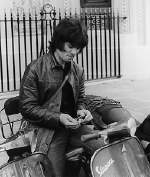
It's all too easy to think of comics as a minority interest, but scratch the surface and you will find comic creators in every walk of life and interest group. There I was, a member of the Scott Walker mailing list expecting talk of music when up pops a post about a self-published comic concerning the musician in question. My interest was roused, so I made enquires....
Darren Schroeder: What is your full name?
Sean Michael Wilson
DS: Age?
SMW: 33
DS: You like Scott Walker's Music: Why?
SMW: I first fell in love with Scott Walker and the Walker brother’s music in winter 1990. I was a student in Glasgow, and very poor. I had just broken the electricity meter and was too scared to call the landlord to come round and fix it. So I was in Glasgow, in a little bedsit room, in the middle of a very cold winter, with nothing but a light bulb to keep me warm. And at that time I bought the Boy child and After the Lights Go Out compilations on LP. After 3 days I got the electricity back and put on the albums. The affect was immediate and deep. It was one of those times in which your 'heart first opened' to something that will stay with you for the rest of your life. Hence the long comic book, Boychild, which I am working on now, is about a fictional character based on the Scott Walker mythology that begun to enthral me that winter in Glasgow.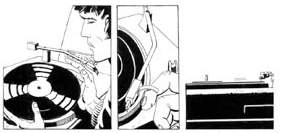
DS: Has a comic ever had a similar impact on you?
SMW: 2000AD had a massive effect on me when I first bought it in November 1981. I went to a newsagent where I lived in Edinburgh to get a boys comic called Victor that was an old fashioned war comic. They were sold out of it and so I saw 2000AD on the shelf instead with a cover by Kevin O'Neil of the story Nemisis. It looked intriguing and when I bought it I was completely bowled over by the art and story. That started me and a bunch of friends into becoming 2000AD fanatics. So that day is the start of my love for comics. Later I bought the short-lived UK comic Warrior and Alan Moore's Swamp Thing which introduced me to more mature comics, and they had a deep impact also.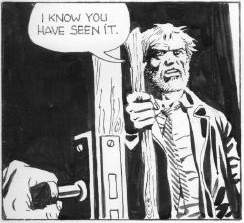 DS: What was the first comic you published yourself and how did that come about?
DS: What was the first comic you published yourself and how did that come about?
SMW: I started making comic books when I was 13 with some friends in Edinburgh, where I grew up. Then after a while I realised that I was not a good enough artist so I concentrated on the writing. I published 5 booklets of poetry and prose poems before coming back to doing comics again. The first published comic I had was in Blink in an independent comic and connected exhibition in the UK during 1998. And now I have my first long graphic novel coming out at present, which is being published thanks to an Arts Council England grant. I am also a filmmaker but I prefer making comic books because they can be more personal in vision, as less people are involved. In fact, I love making comics and I am really enjoying the writing process at the moment.
DS: Filling in all the forms usually associated with grants can be a bit intimidating. What gave you the drive to have a go at applying?
SMW: I have done a ton of filling out forms, as I am also a filmmaker, so I am used to going through very complicated film funding forms. The worst ones are for the European Union Funding, the Arts Council one was easy by comparison!
DS: Was there much of a local comic's scene in Edinburgh?
SMW: As I said above my friends were all powered up by reading 2000AD, it was the common denominator. We then discovered a specialist comic shop called sci-fi bookshop in central Edinburgh and it was like Santa grotto for us, a treasure trove of comic delights! Although ones of my friends was banned from it for a while for calling ones of the owners 'A fat hippy'!
DS: Who do you see as the target audience for your work?
SMW: Mature readers. The kind of comics I write are whatever takes my interest. Normally that means a story in the mature readers tag. The kind of readers who like Alan Moore, Grant Morrison, Dave Sim, European comics etc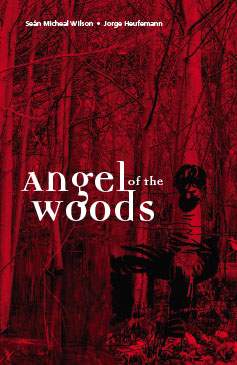 DS: You have a graphic novel Angel of the Woods coming out soon. Describe the story for us.
DS: You have a graphic novel Angel of the Woods coming out soon. Describe the story for us.
SMW: 'A mysterious creature subtly terrorises two young couples on holiday in the woods. Though the others are terrified, one of the young men begins to develop an affinity with the creature, which causes a fundamental psychological change to occur in him. What is the nature of it's interest in him?'
Angel of the Woods appears to be a straight horror story to begin with it, but soon becomes a quite different thing. Rather than being 'blood and guts', it is rather subtle, the monster being mostly on the edges of consciousness. As we read on we see it's really about the personal development of the main character, it's about how magick could actually transform someone individually. It is also, for the most part, realistic in setting, presentation and characters. I think this gives it a rather unusual feeling for a story that is essentially a classical 'birth of the hero' tale.
DS: I'm guessing issues regarding power corrupting come into play here. How do you think you would cope with such powers?
SMW: Actually the issue of what the character does with this new change in life is not explored, angel is about how the change comes about. A sequel might go into what he actually does with the new freedom and power. For me magick is a workable and flexible system of living your life. It's not about dealing with some amazing powers that will corrupt you to the 'Dark side'. The kind of magick I do is more a question of positive thinking and specific techniques for creating a sense of the meaning in your life. But in angel I have kind of fantasized a situation in which a magical creature would turn up to 'Kick start' you into a better life.
DS: What makes someone a hero for you?
SMW: The kind of heroes I have are people like Scott Walker, Terry Stamp, Alan Moore, Franz Kafka, Charles Baudelaire, George Best, John Lennon. I think what these people have in common is that they are all individual artists of one type of another who were carving out a special expressive style of their own under pressure to conform. But now I have met three out of the four of those above who are still alive(!) and I find that I am changing my attitude towards thinking that it's not a great idea to see anyone as a 'Hero'. Because it means you are placing them above you and consequently downgrading yourself, which is unhealthy. It's better to think of yourself as just as valuable as anyone else in the world. Even if some people are better at doing specific things than you, like playing football, still that doesn’t make them fundamentally more important than you. So now I'm dubious about the whole idea of heroes.
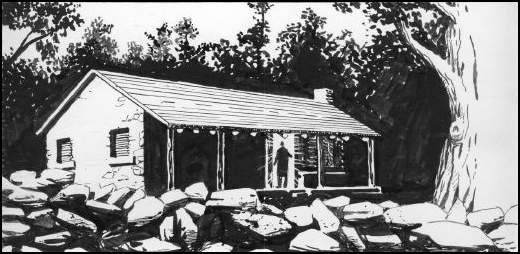
DS: It is rather subtle, the monster being mostly on the edges of consciousness. So you prefer the 'let the viewer think the worst' school of horror?
SMW: I do like the approach of letting people's imaginations create the affect for them. But angel is not really a horror much at all. It comes over as a horror and there is a scary creature in it, but when you read on it becomes really a story about the main's characters change of life.
DS: What comics have you read recently and why did you like/dislike them?
SMW: Harvey Pekar's American Splendour for the realistic subject matter, Promethea by Alan Moore for the astonishing portrayal of the Tarot and Kabbala in issue 12 I think, Uncle Sam by Steve Darnall and Alex Ross for the surprisingly critical account of the American soul, Strangehaven by Gary Spencer Millidge for his skill and tenacity as a solo creator/publisher.
My all time favourite comics are From Hell, V for Vendetta, Cerebus, American Splendour, The Invisibles and 2000AD was a huge influence on me when I was a teenager. I also loved the Scottish cartoon Oor Wullie, for the artwork of Dudley D Watkins and the romanticised version of Scottish culture.
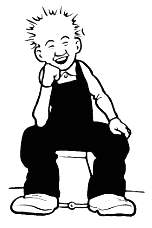 DS: I haven't see that one, describe it for us.
DS: I haven't see that one, describe it for us.SMW: Oor Wullie and another story called The Broons appear in a Scottish newspaper called The Sunday Post Every week. And then it’s collected into albums at the end of the year. So it's a Christmas present kind of thing for children. Both strips started in the 1930's I think. So its now part of Scottish folk culture. They are both comedy stories that show bits of ordinary life of Scottish people. The feeling is of an old-fashioned community based Scottish urban life that has mostly changed now. So its fun to read because its nostalgic and cute. The characters use Scottish words like 'Ken' (Understand) and 'Auld' (Old) and 'Dinnae' (Don't), so I think a lot of people in England can't even understand it!
I've also been researching a lot of Japanese comics recently, becoming familiar with the types of stories, artwork, cultural characteristics etc. I just got married to a Japanese lady in Southern Japan. One of the other stories I am writing now is called Chimpira which is set in Tokyo and about the conflict between a group of young radicals and a Yakuza family. The artist on that is a guy in France called Juan Chavarigga. I'm also in negotiations with a Japanese company in London to begin publishing new Manga stories in English versions.
DS: What differences have you noticed between the Japanese and western comics?
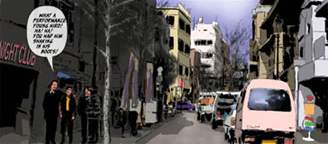 - There are a lot of differences: Japanese comic are much longer, sell much more and are much more respected. The key artistic difference is that Japanese comics show far more small, mundane details that give it a feeling of a poetic and cinematic treatment of the story. What I mean is that they might have 4 or 5 panels that show the subtle change of expression on someone’s face, or a feather floating down and landing on a pond. In western comics this mundane detail would normally be ignored altogether or show in just one or two panels. I love this more poetic Japanese way of telling the story.
- There are a lot of differences: Japanese comic are much longer, sell much more and are much more respected. The key artistic difference is that Japanese comics show far more small, mundane details that give it a feeling of a poetic and cinematic treatment of the story. What I mean is that they might have 4 or 5 panels that show the subtle change of expression on someone’s face, or a feather floating down and landing on a pond. In western comics this mundane detail would normally be ignored altogether or show in just one or two panels. I love this more poetic Japanese way of telling the story.What I don't like so far is that most Japanese comics seem to be very stereotypical in the story content, plot and character type. There appears to be a kind of limited set template for most stories. So we get endless stories of the lone samurai, or a girl trying to win over some guy etc, which follow very predictable formula. But I suppose the same is true of western comics. It’s just that Japanese comics seem to be even more in a strait jacket here. What I do like though is the large variety of subjects that the comics are on ? Cooking, golf, business, boxing, mah jonng games etc. We should have such a variety in the west as well.
DS: Have you found much in the way of Japanese small press?
SMW: There does appear to be 3 groups - the professional, the semi professional and the amateur. And there seems to be a large amount of people doing their own comics. A saw sections in bookshops that were called 'Fanzines', But they looked very well made to me. So I'm not sure how much they sell. Ask me in another three months and I will know a lot more as I am currently working out the final details to begin publishing some of these new semi professional 'Manga- ka' In english versions for the UK/North America ( and New Zealand too!)
DS: Manga and Anima seem to be the current big thing in pop culture if the amount of kids lining up for stuff at the conventions here is any is anything to judge by, so you could be on to a winner there. Any common themes to the material you are looking to publish?
SMW: Boychild manga is definitely a commercial venture for us, done in order to profit from that popularity. But it’s taken for granted that we want to publish good manga, not just any old crap. We will therefore being putting out stories which are well written and drawn versions of the main genres: gangsters, historical, fantasy etc. Hopefully each will be able to combine reasonable commercial potential with a distinctive quality to the comic itself. The key special element is that we will concentrate on publishing new and emerging Japanese creators rather than the established ones already known about in the west. Also we would like to publish some of the alternative style stories from Japan independent creators. So it will be a good opportunity for new ëmanga-kaí, as they are called, to have their stuff shown in english translations.
 DS: What does the term small press mean to you?
DS: What does the term small press mean to you?SMW: The term is clear, it means a small amount printed and distributed anyway you can. The usefulness of self-publishing is obviously control over what you create. The thing is though that the greatest power comes from the combination of good art and good money. By power I mean ability to do what you really want to do, and to be able to have the products of that energy received by other people. So I want to make money as well as having artistic control, and that's the difficult bit, right?
DS: Sure is, but we can only live in hope! What do you think about basing creative decisions on trying to fit the marketplace?
SMW: At the moment i am quite optimistic about that, perhaps foolishly! Basically i think that artistic and commercial pressures are mostly at odds with each other. But some good work is done every day, in all art forms, that is successful commercially and artistically - so it can be done!
DS: Is this the fatal flaw with small press, that they don't have the good money?
SMW: That's the great flaw and the great strength too. Being in a situation of having little money to make your creative work creates certain limitations but frees you from other ones. What I think it that it is possible to have a workable combination of doing high quality creative stuff and making decent money out of it. For your own survival and in order to do more creative work. And finally if you do reach quite a lot of people with your creative work then there is a positive power in that.
 DS: How did you team up with the Argentinean artist Jorge Heufemann?
DS: How did you team up with the Argentinean artist Jorge Heufemann?SMW: I put an advert for an artist on the Digital webbing site and got lots of replies. I was looking for somebody with a European style to their art, and being from South America he had Italian, Spanish and French influences in his style. Someone said Jorge's art looks a little like Hugo Pratt of Corto Maltese fame. We've worked well together, mostly over the internet, though we had a few heated disagreements about panel construction, dialogue and such stuff in the making of Angel of the woods. Now we are working together on the boychild story and I have already sent him about 30 photographs in jpeg form of haircuts, clothes, cars, suits etc from the mid to late 60's so he can get the details just right. It's very important that this story is authentic in its details.
DS: How difficult do you find it dealing with the give and take required with collaborating on a story?
SMW: As I said before I have had some big fights with artists, especially as I can sometimes be rather demanding about details inside the panels and the structure of panels on the page. But 90% of the time it is smooth and you agree quickly. It is an artistic partnership fundamentally, so you should try to agree to something mutually acceptable. Basically I think that the artist normally has a better sense of the overall visual structure of the page and comic as a whole than the writer, but the writer knows the dynamic and essence of the story better, and they are the one who takes it forward. That's kind of obvious I guess. Personally I do often get upset when a big argument arises over some aspect of the art, because I care about the story and my personality is a rather over sensitive one. But this happens rarely. Most of the time it can be worked out in a friendly way - so far!
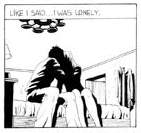 DS: How do you develop an idea into a comic - from script to layout or from drawings?
DS: How do you develop an idea into a comic - from script to layout or from drawings?SMW: I have these notebooks that I have been writing in since Nov 1987 I'm now up to notebook 130 I think! So I write down all my ideas in my present notebook, which come to me almost everyday, then the ones that stick in my mind or seem particularly interesting I work up into a plot or synopsis which describes the whole flow of the story. Then I agree on an artist who will be suitable to the type of art that is required and who likes the story. I then start writing the script and send it to them bit by bit. They send the art back to me in person or via email when it is at the rough stage and we discuss possible changes. Then try to agree on the final pages. It works fine most of the time, though recently me and the artist on Boychild Have had big disagreements about certain details of the art. So it can be a difficult process.
I don't often do sketches though sometimes I do. Gary Spencer Millidge of Strangehaven comic recently said to me that he can't visualise a comic from the format of a written script, he prefers to do thumbnails sketches and work them up into the finished art. That's fair enough too, whatever works for you.
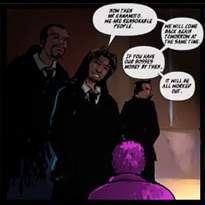 DS: If we imagine a battle is going on between film & comics for the hearts of the public, it appears film is winning. Why is that?
DS: If we imagine a battle is going on between film & comics for the hearts of the public, it appears film is winning. Why is that?SMW: Here are some reasons possibly: comics are still thought of as mainly for children in many countries. So have a poor reputation in some places. Film and television obviously are moving, so attract our attention more quickly and easily. It's easier to watch a film than read a comic, it's more passive, and it takes less mental effort. And the physical flickering of the images has a hypnotic effect that drags us in and becomes addictive i think. It relaxes the viewer more and takes them mentally out of their problems. Comics do all these things too, but its more of an active mental process and less trance like. Financially too there is more money to be made from films than comics so the capitalist system is geared more towards films than comics. I think there is also a certain lack of faith in the financial and artistic potential of comics, which maybe partly fuelled by the low cultural esteem they are held in some countries. So it’s a catch 22 situation: low esteem = not willing to invest = few good comics = decline in readership = even less good comics = further low esteem and so on.
DS: Describe the view out your front door.
SMW: In the front garden i have a cool vespa scooter from 1969 and right next to it a little white mini car, one of the few cars that i like.
DS: How do you distribute your comics?
SMW: For Angel of the Woods we have got a deal with diamond distributors and fm international also, plus probably red route in the UK for re-orders. It will also be available direct via our website at http://www.boychildproductions.co.uk. We will also feature them on http://www.amazon.co.uk and comic markets (we are going to the french Angouleme comic book festival in Jan 2004) etc. The other comics will be available through these routes also hopefully.
DS: Thanks for your time. Best of luck.
If you have a comment or question about Small Press then feel free to contact me